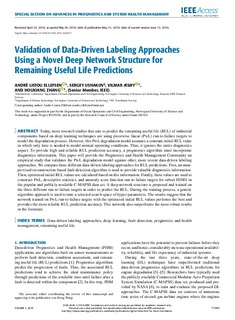| dc.contributor.author | Ellefsen, Andre | |
| dc.contributor.author | Ushakov, Sergey | |
| dc.contributor.author | Æsøy, Vilmar | |
| dc.contributor.author | Zhang, Houxiang | |
| dc.date.accessioned | 2019-06-17T09:44:05Z | |
| dc.date.available | 2019-06-17T09:44:05Z | |
| dc.date.created | 2019-06-12T13:17:04Z | |
| dc.date.issued | 2019 | |
| dc.identifier.citation | IEEE Access. 2019, 7 71563-71575. | nb_NO |
| dc.identifier.issn | 2169-3536 | |
| dc.identifier.uri | http://hdl.handle.net/11250/2600971 | |
| dc.description.abstract | Today, most research studies that aim to predict the remaining useful life (RUL) of industrial components based on deep learning techniques are using piecewise linear (PwL) run-to-failure targets to model the degradation process. However, this PwL degradation model assumes a constant initial RUL value in which only time is needed to model normal operating conditions. Thus, it ignores the entire diagnostics aspect. To provide high and reliable RUL prediction accuracy, a prognostics algorithm must incorporate diagnostics information. This paper will provide the Prognostics and Health Management Community an empirical study that validates the PwL degradation model against other, more recent data-driven labeling approaches. We compare three different data-driven labeling approaches for RUL predictions. First, an unsupervised reconstruction-based fault detection algorithm is used to provide valuable diagnostics information. Then, optimized initial RUL values are calculated based on this information. Finally, these values are used to construct PwL, descriptive statistics, and anomaly score function run-to-failure targets for subset FD001 in the popular and publicly available C-MAPSS data set. A deep network structure is proposed and trained on the three different run-to-failure targets in order to predict the RUL. During the training process, a genetic algorithm approach is used to tune a selected search space of hyper-parameters. The results suggest that the network trained on PwL run-to-failure targets with the optimized initial RUL values performs the best and provides the most reliable RUL prediction accuracy. This network also outperforms the most robust results in the literature. | nb_NO |
| dc.language.iso | eng | nb_NO |
| dc.publisher | Institute of Electrical and Electronics Engineers (IEEE) | nb_NO |
| dc.title | Validation of Data-Driven Labeling Approaches Using a Novel Deep Network Structure for Remaining Useful Life Predictions | nb_NO |
| dc.type | Journal article | nb_NO |
| dc.type | Peer reviewed | nb_NO |
| dc.description.version | publishedVersion | nb_NO |
| dc.source.pagenumber | 71563-71575 | nb_NO |
| dc.source.volume | 7 | nb_NO |
| dc.source.journal | IEEE Access | nb_NO |
| dc.identifier.doi | 10.1109/ACCESS.2019.2920297 | |
| dc.identifier.cristin | 1704342 | |
| dc.relation.project | Norges forskningsråd: 280703 | nb_NO |
| dc.description.localcode | 2019 IEEE. Translations and content mining are permitted for academic research only. Personal use is also permitted, but republication/redistribution requires IEEE permission. | nb_NO |
| cristin.unitcode | 194,64,93,0 | |
| cristin.unitcode | 194,64,20,0 | |
| cristin.unitname | Institutt for havromsoperasjoner og byggteknikk | |
| cristin.unitname | Institutt for marin teknikk | |
| cristin.ispublished | true | |
| cristin.fulltext | postprint | |
| cristin.qualitycode | 1 | |
